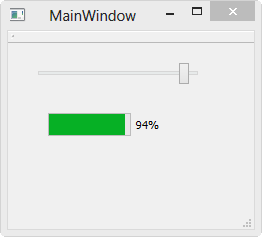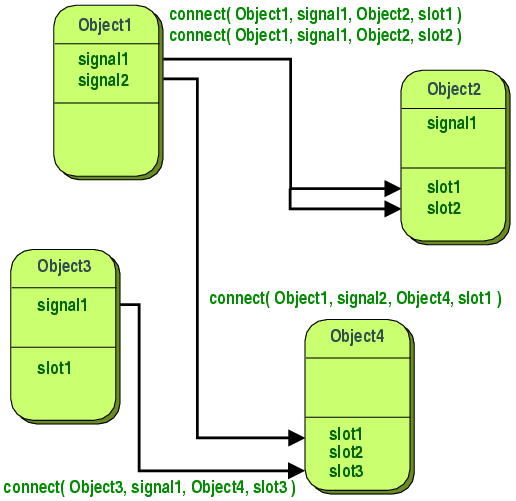Signals and Slots. Signals and Slots are a feature of Qt used for communication between objects. When something happens to an object, it can emit a signal. Zero or more objects can listen for this signal using a slot, and act on it. The signal doesn’t know if anything is listening to it, and the slot doesn’t know what object called it. Qt has a unique signal and slot mechanism. This signal and slot mechanism is an extension to the C programming language. Signals and slots are used for communication between objects. A signal is emitted when a particular event occurs. A slot is a normal C method; it is called when a signal connected to it is emitted. One key and distinctive feature of Qt framework is the use of signals and slots to connect widgets and related actions. But as powerful the feature is, it may look compelling to a lot of developers not used to such a model, and it may take some time at the beginning to get used to understand how to use signals and slots properly. The text in the signal & slot explanatory part below the graph and shortly before the heading Signals is You can connect as many signals as you want to a single slot, and a signal can be connected to as many slots as you need. It is even possible to connect a signal directly to another signal. (This will emit the second signal immediately.
Signals are a neat feature of Qt that allow you to pass messages between different components in your applications.
Signals are connected to slots which are functions (or methods) which will be run every time the signal fires. Many signals also transmit data, providing information about the state change or widget that fired them. The receiving slot can use this data to perform different actions in response to the same signal.

However, there is a limitation: the signal can only emit the data it was designed to. So for example, a QAction has a .triggered that fires when that particular action has been activated. The triggered signal emits a single piece of data -- the checked state of the action after being triggered.
For non-checkable actions, this value will always be False
Qt Signals And Slots Between Classes For Beginners
The receiving function does not know whichQAction triggered it, or receiving any other data about it.
This is usually fine. You can tie a particular action to a unique function which does precisely what that action requires. Sometimes however you need the slot function to know more than that QAction is giving it. This could be the object the signal was triggered on, or some other associated metadata which your slot needs to perform the intended result of the signal.
This is a powerful way to extend or modify the built-in signals provided by Qt.
Intercepting the signal
Instead of connecting signal directly to the target function, youinstead use an intermediate function to intercept the signal, modify the signal data and forward that on to your actual slot function.
This slot function must accept the value sent by the signal (here the checked state) and then call the real slot, passing any additional data with the arguments.
Rather than defining this intermediate function, you can also achieve the same thing using a lambda function. As above, this accepts a single parameter checked and then calls the real slot.
In both examples the <additional args> can be replaced with anything you want to forward to your slot. In the example below we're forwarding the QAction object action to the receiving slot.
Our handle_trigger slot method will receive both the original checked value and the QAction object. Or receiving slot can look something like this
Qt Signals And Slots Between Classes Online
Below are a few examples using this approach to modify the data sent with the MainWindow.windowTitleChanged signal.
- PyQt5
- PySide2
The .setWindowTitle call at the end of the __init__ block changes the window title and triggers the .windowTitleChanged signal, which emits the new window title as a str. We've attached a series of intermediate slot functions (as lambda functions) which modify this signal and then call our custom slots with different parameters.

Running this produces the following output.
The intermediate functions can be as simple or as complicated as you like -- as well as discarding/adding parameters, you can also perform lookups to modify signals to different values.
In the following example a checkbox signal Qt.Checked or Qt.Unchecked is modified by an intermediate slot into a bool value.
- PyQt5
- PySide2
In this example we've connected the .stateChange signal to result in two ways -- a) with a intermediate function which calls the .result method with True or False depending on the signal parameter, and b) with a dictionary lookup within an intermediate lambda.

Running this code will output True or False to the command line each time the state is changed (once for each time we connect to the signal).
QCheckbox triggering 2 slots, with modified signal data
Trouble with loops
One of the most common reasons for wanting to connect signals in this way is when you're building a series of objects and connecting signals programmatically in a loop. Unfortunately then things aren't always so simple.
If you try and construct intercepted signals while looping over a variable, and want to pass the loop variable to the receiving slot, you'll hit a problem. For example, in the following code we create a series of buttons, and use a intermediate function to pass the buttons value (0-9) with the pressed signal.
- PyQt5
- PySide2
If you run this you'll see the problem -- no matter which button you click on you get the same number (9) shown on the label. Why 9? It's the last value of the loop.
The problem is the line lambda: self.button_pressed(a) where we pass a to the final button_pressed slot. In this context, a is bound to the loop.

However, there is a limitation: the signal can only emit the data it was designed to. So for example, a QAction has a .triggered that fires when that particular action has been activated. The triggered signal emits a single piece of data -- the checked state of the action after being triggered.
For non-checkable actions, this value will always be False
Qt Signals And Slots Between Classes For Beginners
The receiving function does not know whichQAction triggered it, or receiving any other data about it.
This is usually fine. You can tie a particular action to a unique function which does precisely what that action requires. Sometimes however you need the slot function to know more than that QAction is giving it. This could be the object the signal was triggered on, or some other associated metadata which your slot needs to perform the intended result of the signal.
This is a powerful way to extend or modify the built-in signals provided by Qt.
Intercepting the signal
Instead of connecting signal directly to the target function, youinstead use an intermediate function to intercept the signal, modify the signal data and forward that on to your actual slot function.
This slot function must accept the value sent by the signal (here the checked state) and then call the real slot, passing any additional data with the arguments.
Rather than defining this intermediate function, you can also achieve the same thing using a lambda function. As above, this accepts a single parameter checked and then calls the real slot.
In both examples the <additional args> can be replaced with anything you want to forward to your slot. In the example below we're forwarding the QAction object action to the receiving slot.
Our handle_trigger slot method will receive both the original checked value and the QAction object. Or receiving slot can look something like this
Qt Signals And Slots Between Classes Online
Below are a few examples using this approach to modify the data sent with the MainWindow.windowTitleChanged signal.
- PyQt5
- PySide2
The .setWindowTitle call at the end of the __init__ block changes the window title and triggers the .windowTitleChanged signal, which emits the new window title as a str. We've attached a series of intermediate slot functions (as lambda functions) which modify this signal and then call our custom slots with different parameters.
Running this produces the following output.
The intermediate functions can be as simple or as complicated as you like -- as well as discarding/adding parameters, you can also perform lookups to modify signals to different values.
In the following example a checkbox signal Qt.Checked or Qt.Unchecked is modified by an intermediate slot into a bool value.
- PyQt5
- PySide2
In this example we've connected the .stateChange signal to result in two ways -- a) with a intermediate function which calls the .result method with True or False depending on the signal parameter, and b) with a dictionary lookup within an intermediate lambda.
Running this code will output True or False to the command line each time the state is changed (once for each time we connect to the signal).
QCheckbox triggering 2 slots, with modified signal data
Trouble with loops
One of the most common reasons for wanting to connect signals in this way is when you're building a series of objects and connecting signals programmatically in a loop. Unfortunately then things aren't always so simple.
If you try and construct intercepted signals while looping over a variable, and want to pass the loop variable to the receiving slot, you'll hit a problem. For example, in the following code we create a series of buttons, and use a intermediate function to pass the buttons value (0-9) with the pressed signal.
- PyQt5
- PySide2
If you run this you'll see the problem -- no matter which button you click on you get the same number (9) shown on the label. Why 9? It's the last value of the loop.
The problem is the line lambda: self.button_pressed(a) where we pass a to the final button_pressed slot. In this context, a is bound to the loop.
Qt Signals And Slots Between Classes
We are not passing the value of a when the button is created, but whatever value a has when the signal fires. Since the signal fires after the loop is completed -- we interact with the UI after it is created -- the value of a for every signal is the final value that a had in the loop: 9.
So clicking any of them will send 9 to button_pressed
The solution is to pass the value in as a (re-)named parameter. This binds the parameter to the value of a at that point in the loop, creating a new, un-connected variable. The loop continues, but the bound variable is not altered.
This ensures the correct value whenever it is called.
Qt Signals And Slots Between Classes Near Me
You don't have to rename the variable, you could also choose to use the same name for the bound value.
The important thing is to use named parameters. Putting this into a loop, it would look like this:
Running this now, you will see the expected behavior -- with the label updating to a number matching the button which is pressed.
The working code is as follows:
- PyQt5
- PySide2

